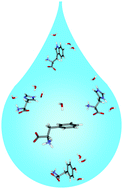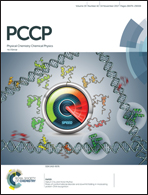Privileged hydration sites in aromatic side chains: effect on conformational equilibrium†
Abstract
Water interaction with peptide chains is one of the key structure stabilizing factors in an aqueous environment. Because of its strong polar character, water can bind to both anionic and cationic sites via electrostatic interactions. It can also act as a hydrogen-bond donor or acceptor according to its interactions with different polar groups in the backbone and side chains of peptides and proteins. Based on density functional theory calculations, the present report aims at illustrating the most energetically favorable interaction sites of aromatic side chains of phenylalanine, tyrosine, tryptophan, and histidine (neutral and protonated species) with surrounding water molecules. It was shown that beyond the strong interactions occurring between water and the aromatic ring acceptor/donor sites, such as O–H, N–H and –N![[double bond, length as m-dash]](https://www.rsc.org/images/entities/char_e001.gif) groups, weaker interactions with π-electron clouds should also be considered. The latter type of binding, hereafter referred to as Hw⋯π interaction, involves one of the water hydrogen atoms (Hw) pointing toward the aromatic ring. Upon comparison between the theoretical data obtained from a purely implicit hydration model, i.e. a polarized solvent continuum, and those collected from a mixture of implicit and explicit hydration models, it has been shown that the explicit water molecule binding to aromatic rings affects the relative energies of the rotamers generated by the two side chain torsion angles (χ1 and χ2).
groups, weaker interactions with π-electron clouds should also be considered. The latter type of binding, hereafter referred to as Hw⋯π interaction, involves one of the water hydrogen atoms (Hw) pointing toward the aromatic ring. Upon comparison between the theoretical data obtained from a purely implicit hydration model, i.e. a polarized solvent continuum, and those collected from a mixture of implicit and explicit hydration models, it has been shown that the explicit water molecule binding to aromatic rings affects the relative energies of the rotamers generated by the two side chain torsion angles (χ1 and χ2).



 Please wait while we load your content...
Please wait while we load your content...